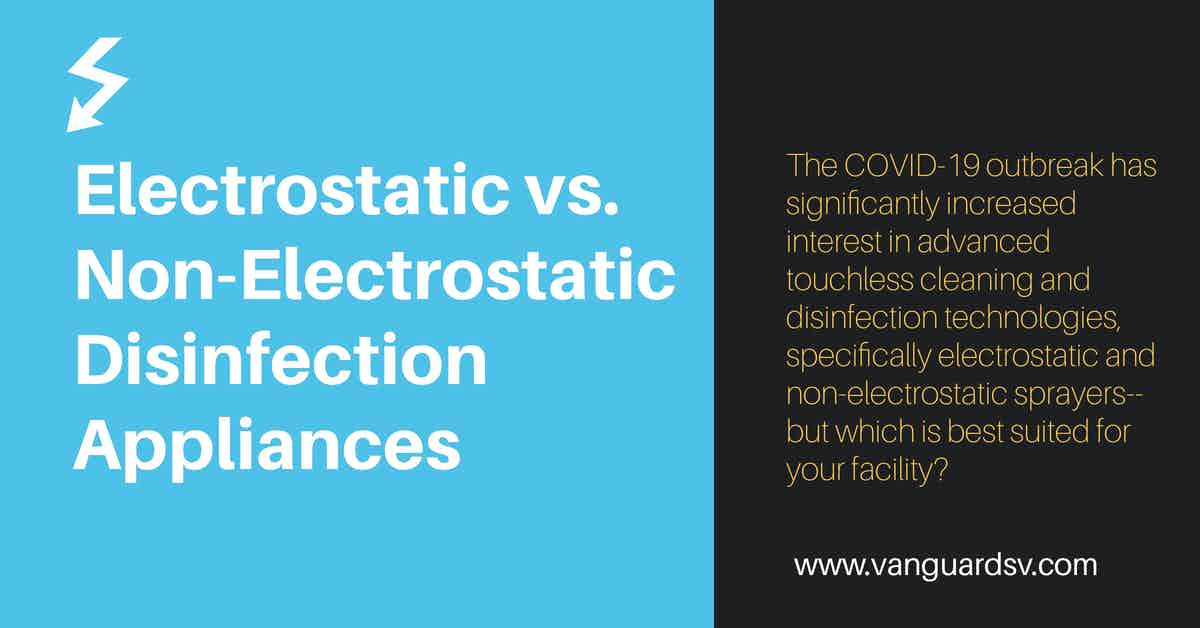The COVID-19 outbreak has significantly increased interest in advanced touchless cleaning and disinfection technologies, specifically electrostatic and non-electrostatic sprayers--but which is best suited for your facility?

Comparing Electrostatic and Non-Electrostatic Disinfection Appliances
In the wake of the SARS-CoV-2 outbreak, many school administrators, facility managers, and business owners have taken a keen interest in technologies that increase custodial efficiency, facility hygiene, and occupant safety.
Chief among those technologies has been automated spraying applicators--electrostatic sprayers and electronic, non-electrostatic sprayers.
While the two technologies are similar in function and design, a key difference exists that will determine which version is right for your facility--the ability to thoroughly coat an entire three-dimensional surface.
Non-electrostatic disinfection appliances spray out a fine mist of disinfectant onto a surface and are ideal for large areas with flat surfaces, such as school gymnasiums, classrooms, and touchpoints.
Electrostatic disinfection appliances operate much in the same manner, but the mist is electrostatically charged so that when it lands on a surface, it does not bead up, but spreads out evenly, proving a full 360-degree coverage, making them ideal for areas with large, difficult to clean furniture, such as gyms, classrooms with desks and computers, offices, and conference rooms.
Another significant difference that may impact your organization's decision to purchase one or the other type of appliance is the need for specialized chemicals.
More often than not, electrostatic disinfection appliances will require the use of proprietary products to function correctly, while non-electrostatic sprayers can use more conventional disinfectants, such as:
- Aldehyde.
- Phenolic.
- Quaternary Ammonium Compounds.
- Sodium Hypochlorite (Bleach).
- Peroxyacetic Acid, or;
- Hydrogen Peroxide.
Why Choose Electrostatic Disinfection
Electrostatic disinfection is vastly superior to conventional disinfection methods in several ways.
Traditional methods, often incorporating spray bottles, dirty buckets, cleaning rags, and outdated cotton-swab mops:
- Typically miss large areas that are difficult for the cleaning team to reach.
- Require as many as five times the personnel to disinfect the same space when compared to electrostatic spray technologies.
- Cost more money long-term due to the number of custodial workers and the amount of time required to deliver a sub-par outcome.
- Contribute to repetitive motion injuries common to custodial staff.
- Lead to surface cross-contamination and the spread of deadly pathogens and bacteria, even when using microfiber.
- Waste expensive disinfection products and natural resources.
- Are prone to accidents and, sometimes, deadly emergencies due to inaccurate dilution or accidental mixing of corrosive chemicals, and;
- Expose workers directly to potentially contaminated surfaces.
According to Cleaning and Maintenance Magazine;
Many facilities are already seeing dramatic drops in labor costs and expenses due to faster disinfection times and triple surface coverage per ounce.
In a matter of minutes, workers disinfect entire areas with just a quick pass of the electrostatic device over potentially contaminated surfaces.
Additionally, many safety benefits are associated with electrostatic disinfection processes.
Applying chemicals in a more uniform and controlled manner removes the dangers of overuse and reduces waste and chemical use by as much as 60% per square foot.
Desktops, computers, and other equipment can be safely disinfected by applying non-corrosive and compatible chemistries with electrostatic sprayers.
These sprayers can also help eliminate odors at their source, control pests, and make mold remediation faster and more cost-effective.
Undoubtedly, the most valuable benefit is the ability to proactively prevent the spread of infectious viruses.
Because electrostatic application is touchless, there’s no risk for cross-contamination, whereas microfiber towels or wipes can potentially transfer microbes from surface to surface.
Improving Disinfection Outcomes with Electrostatic Technologies
References & Resources
Takeaway
No-touch technologies, such as electrostatic disinfection, decrease the amount of direct contact custodial staff have with potentially contaminated surfaces, thereby reducing the chance that they will come in contact with the SARS-CoV-2 virus and spread it around the facility or to another person.
Additionally, these technologies decrease the amount of time and the number of people it takes to fully clean and disinfect a facility, ensuring a fast return on investment and a healthier workplace or classroom.
Alternatively, outsourcing to a service provider already in possession of the equipment and trained personnel required to operate the systems can eliminate upfront purchase costs, as well as long-term training and maintenance expenses.
If you would like more information regarding the effectiveness of high-performance infection prevention and control measures, or if you would like to schedule a free, no-obligation onsite assessment of your facility's custodial needs, contact us today for a free quote!
In Bakersfield CA, call (661) 437-3253
In Fresno CA, call (559) 206-1059
In Valencia CA, or Santa Clarita CA, call (661) 437-3253
In Palmdale CA, or Lancaster CA, call (661) 371-4756

